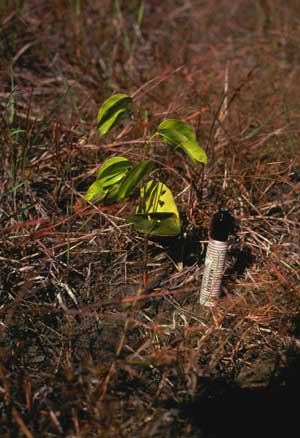|
|
 86 mycorrhizal fungi DHJanzen100850.jpg high resolution
|
|
| Even with seed dispersers and good soil, there are some additional barriers to forest establishment in old pastures. This very slow-growing and stunted Hymenaea courbaril tree, planted in the early 1980s but still (2001) the same size, is barely hanging on. Its problem is not soil or water or competition from the grass. Its problem is that it has never acquired a mutualistic interaction with fungi on its roots. These fungi - some of which you have heard of as truffles - are proficient at gathering minerals from the surrounding soil, minerals that they transfer to the plant in return for carbohydrates made by the plant through its photosynthesis. The relevant species of fungi are commonplace in the soils below the forest canopy, mutualists with tree roots. But in ancient pastures, these fungi may be much scarcer and it can take years for the seedling to acquire the mutualism. During that time, it is much more susceptible to other stresses than it would be if it had its mutualists. The fungi themselves are lumped under the general term mycorrhizal fungi, and the combination of roots and fungi is generally refererred to as a mycorrhiza (mycorrhizae for plural). A standard solution to solving the problem mentioned here is to grow tree seedlings in bags of soil collected from the forest understory, and especially, with chopped tree roots mixed in. Then the seedling, soil and all, is transplanted into the open pasture (at an obviously higher cost than tree planting by wind and wild vertebrates). | ||
back to lecture slides
or skip to: